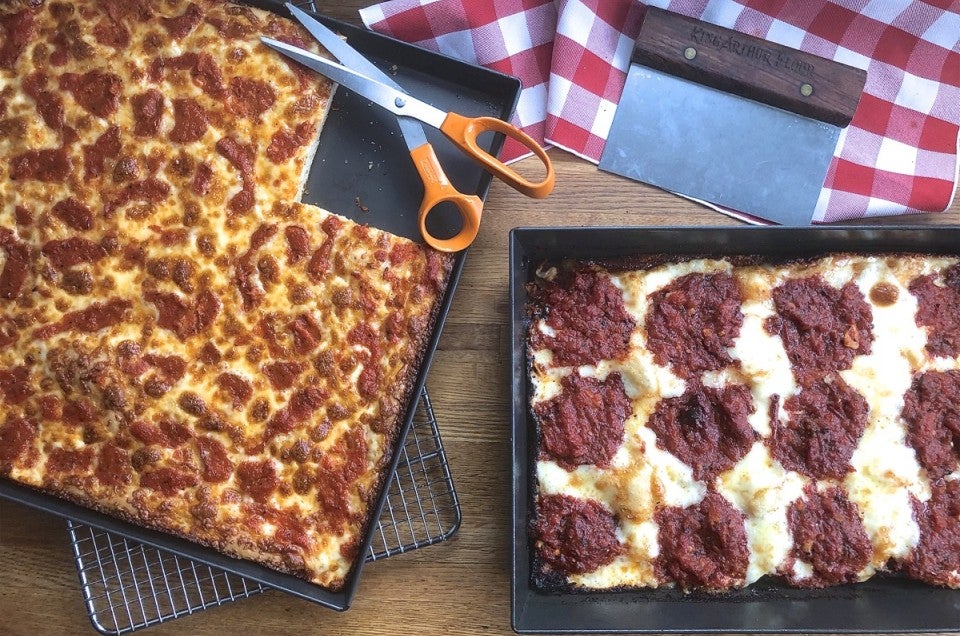


What’s your favorite pizza style: thin crust or thick? Neapolitan-style pizza, with its characteristic charred bottom, super-thin round crust, and minimal toppings, has been a New York City tradition for over 100 years. But thicker, heartier pan pizza, smothered in sauce and cheese and baked in a square or rectangular pan, boasts a history that’s just as old — and suddenly hip.
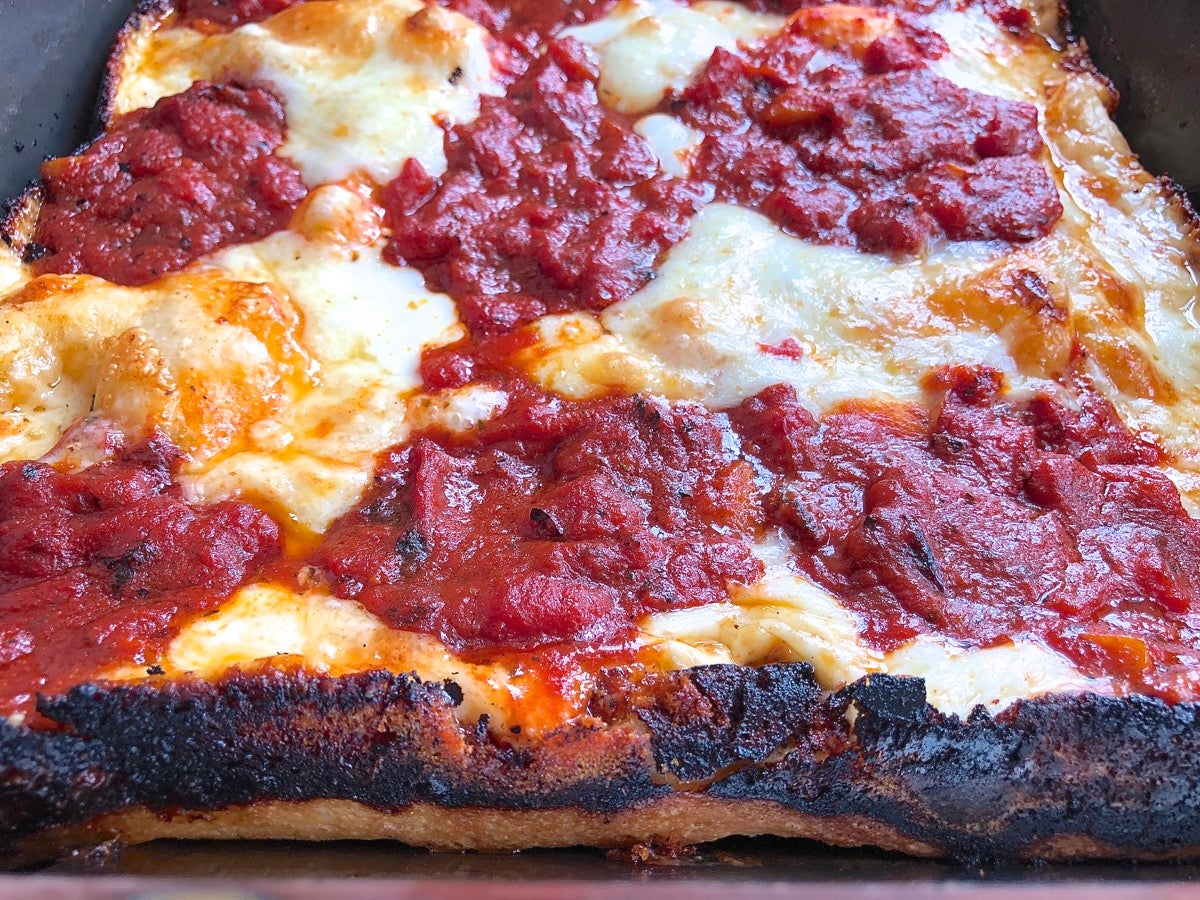
Witness the increasing buzz around Detroit-style pizza and grandma pizza, two variations on pan pizza.
Detroit-style pizza, a dish born at Buddy's Rendezvous (later to become Buddy's Pizza) in Detroit more than 70 years ago, is characterized by its towering crust (over 1” thick), its crisp “fried” bottom, blobs of sauce in place of an even layer, and most importantly, crunchy, deep-brown (almost black) baked cheese around the edges.

Grandma pizza, born on Long Island outside New York City, is similar to Sicilian-style, probably the most ubiquitous of pan pizzas nationwide. But where Sicilian-style pan pizza is thick (typically 1”) and light-textured, grandma pizza is chewy and thinner — only about 3/4” thick.
Baked in an oil-coated pan yielding an extra-crunchy bottom crust, like Detroit, grandma pizza also employs a similar topping technique: the cheese is laid down first, followed by the sauce. Arranged in a thick layer right to the edge of the pan, the cheese becomes a deep golden brown — nearly burned — while the pie bakes.
If you're a thin-crust pizza fan, you may think these thick-crust pies are from the dark side. And you're right: their deep-gold bottom crust and crunchy baked cheese edges are definitely dark — and absolutely delicious!
Gather your ingredients:
For the dough:
2 1/2 cups (298g) King Arthur Unbleached Bread Flour
1 1/2 teaspoons instant yeast
1 tablespoon Pizza Dough Flavor, optional; for added flavor
1 teaspoon salt
1 cup (227g) lukewarm water
olive oil, for greasing the pan
For the sauce:
2 tablespoons (25g) olive oil
2 cloves of garlic, peeled and finely chopped
1 tablespoon Pizza Seasoning or dried Italian herbs
28-ounce can crushed tomatoes
1 tablespoon sugar, optional
For the toppings:
8 to 12 ounces (227g to 340g) pepperoni, sliced 1/8" thick, optional
6 ounces (170g) mozzarella cheese, cut into 1/2" cubes
6 ounces (170g) cheddar cheese, cut into 1/2" cubes
Weigh out your flour, or measure it by gently spooning it into a cup, then sweeping off any excess.
Mix and knead all the dough ingredients until a shaggy dough forms.

Cover the dough, allow it to rest for 10 minutes, then knead it again until it becomes smooth and elastic.

Form the dough into a ball, place it into a lightly greased bowl, cover, and allow to rest until doubled, about 2 hours.
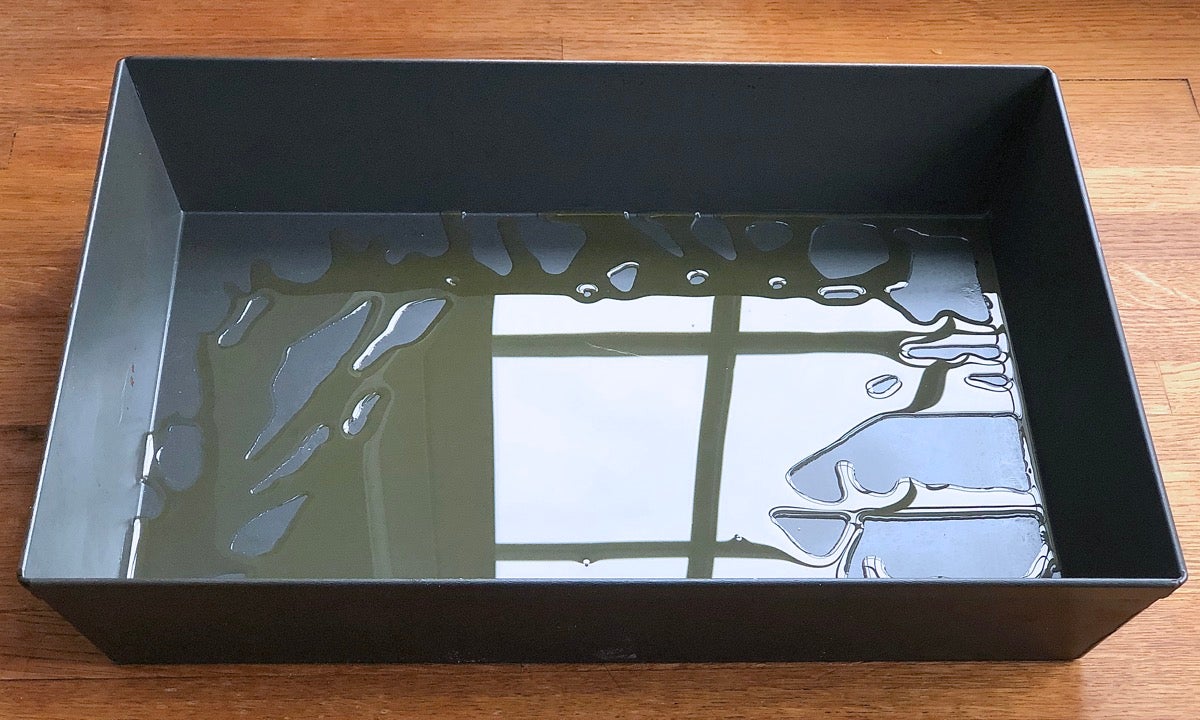
Drizzle 1 to 2 tablespoons of olive oil into a Detroit-style pizza pan or a 9” x 13” pan. The dark Detroit-style pan will yield a crustier crust and crunchier edges.

Gently stretch the dough towards the edges and corners of the pan until it starts to shrink back and won’t stretch any farther.

Cover the pan, and allow the dough to rest and relax for 15 to 20 minutes before stretching it again. Repeat the rest one more time, if necessary, until the dough fills the bottom of the pan.
Position a rack at the lowest position of the oven, and start preheating the oven to 500°F.
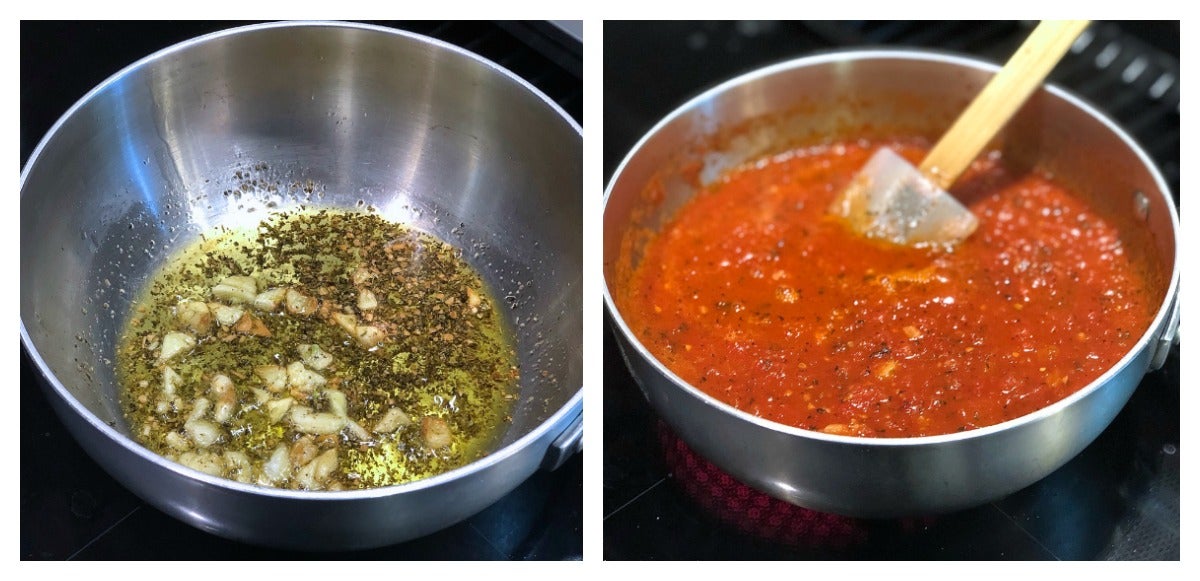
While the oven heats, make the sauce (or use your prepared favorite). Heat the olive oil in a saucepan set over medium heat until shimmering. Stir in the garlic and Pizza Seasoning or dried herbs and cook until fragrant, about 30 seconds.
Add the tomatoes and sugar, bring to a simmer, and cook until the juices have reduced significantly and you have about 3 cups of sauce, about 20 minutes. Remove the sauce from the heat and set aside.
Gently press the dough down with your fingers to release some larger air bubbles, if necessary. Top the dough with an even layer of pepperoni, if using; I'm skipping the pepperoni.
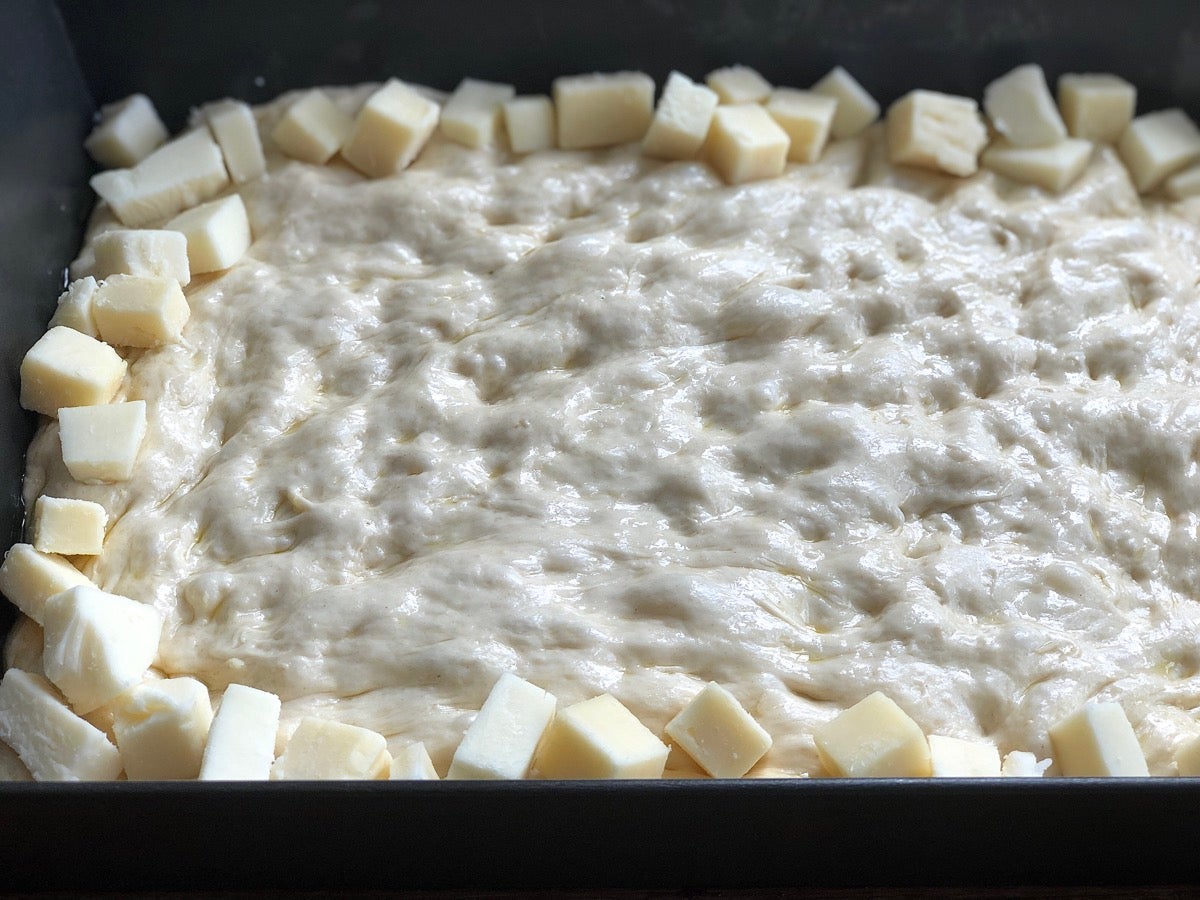

Top with the cubed cheeses, making sure to spread them to the edges of the pan.
Why cubed rather than shredded cheese? Cubed cheese makes a big cheese-y statement once the pizza is baked. Some of the cubes retain a soft but evident core, while others melt completely, pooling atop the crust and running over the edges. Oh, my...
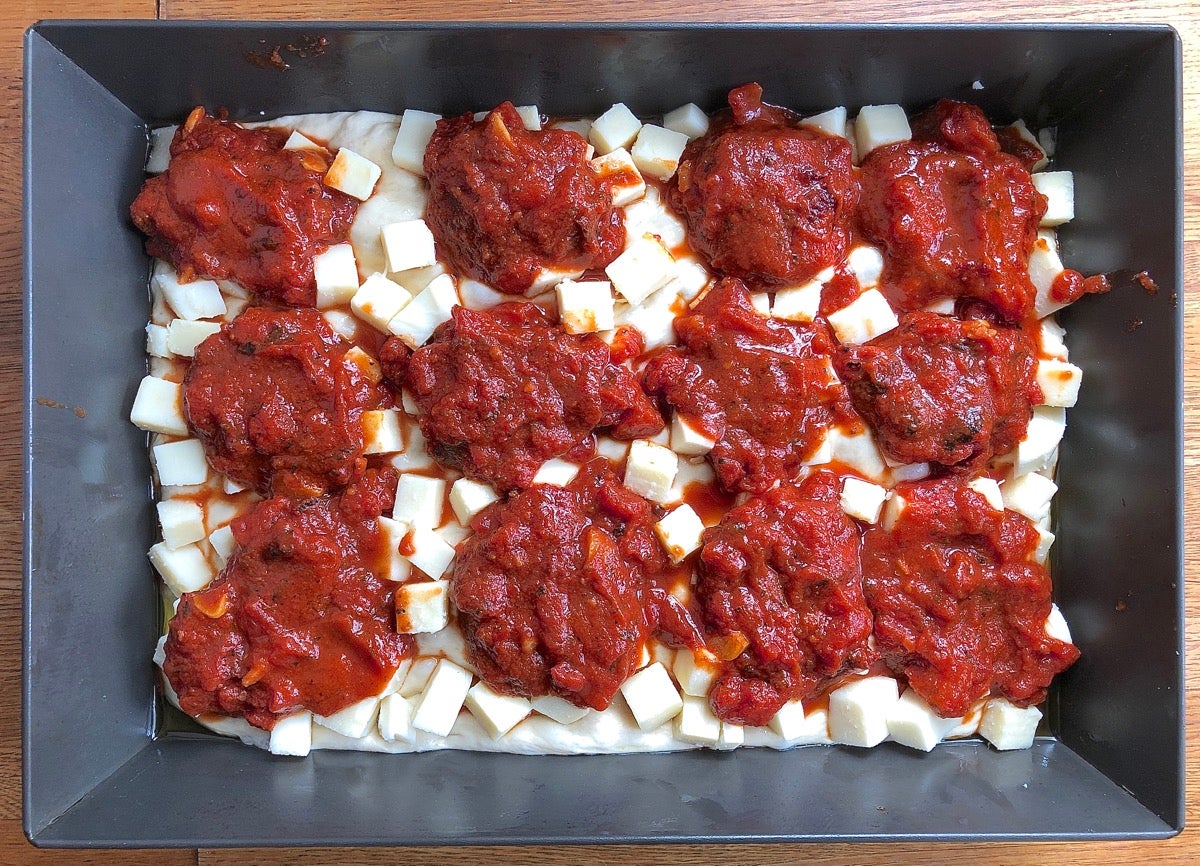
Dollop the sauce over the surface of the pizza or spread it into three lengthwise rows. I decide to dollop sauce in the approximate center of what will eventually be 12 squares.
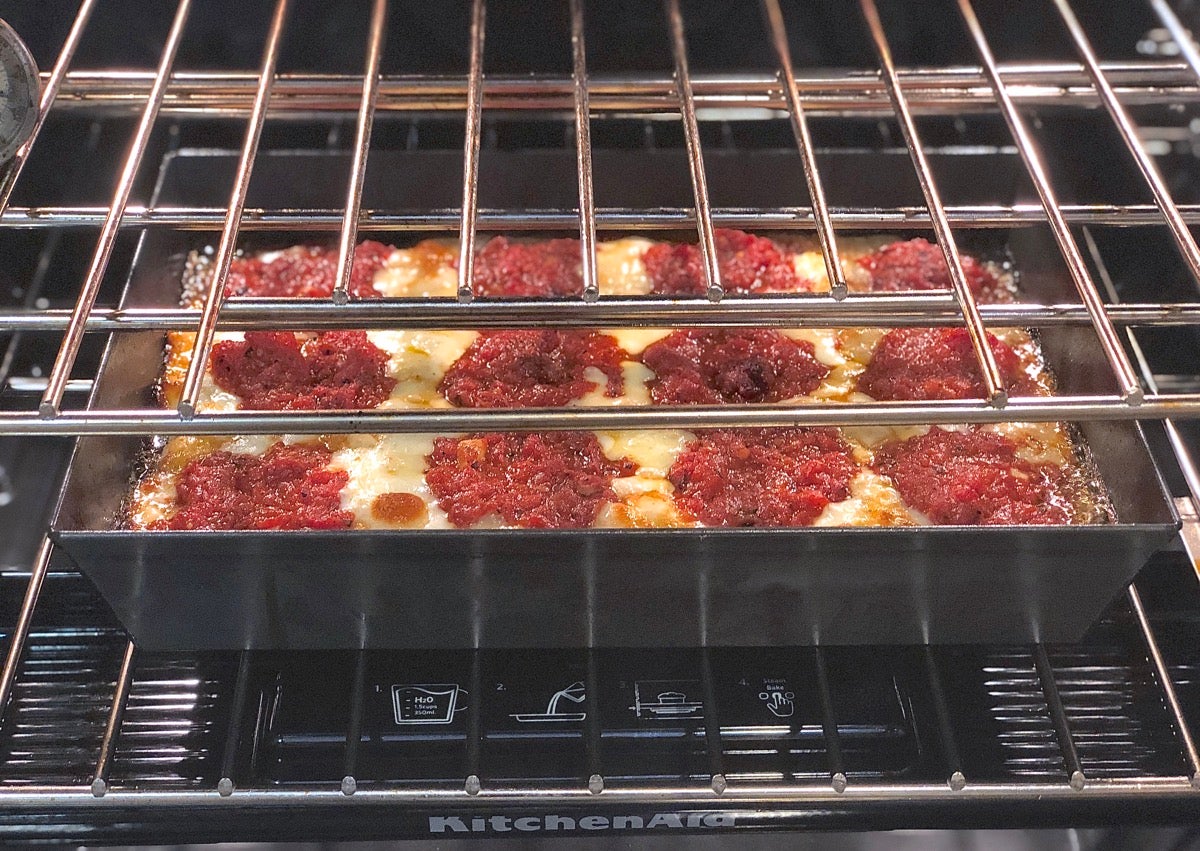
Transfer the pizza to the bottom rack of the oven, and bake until the cheese is bubbly and the edges have turned nearly black, about 12 to 15 minutes.
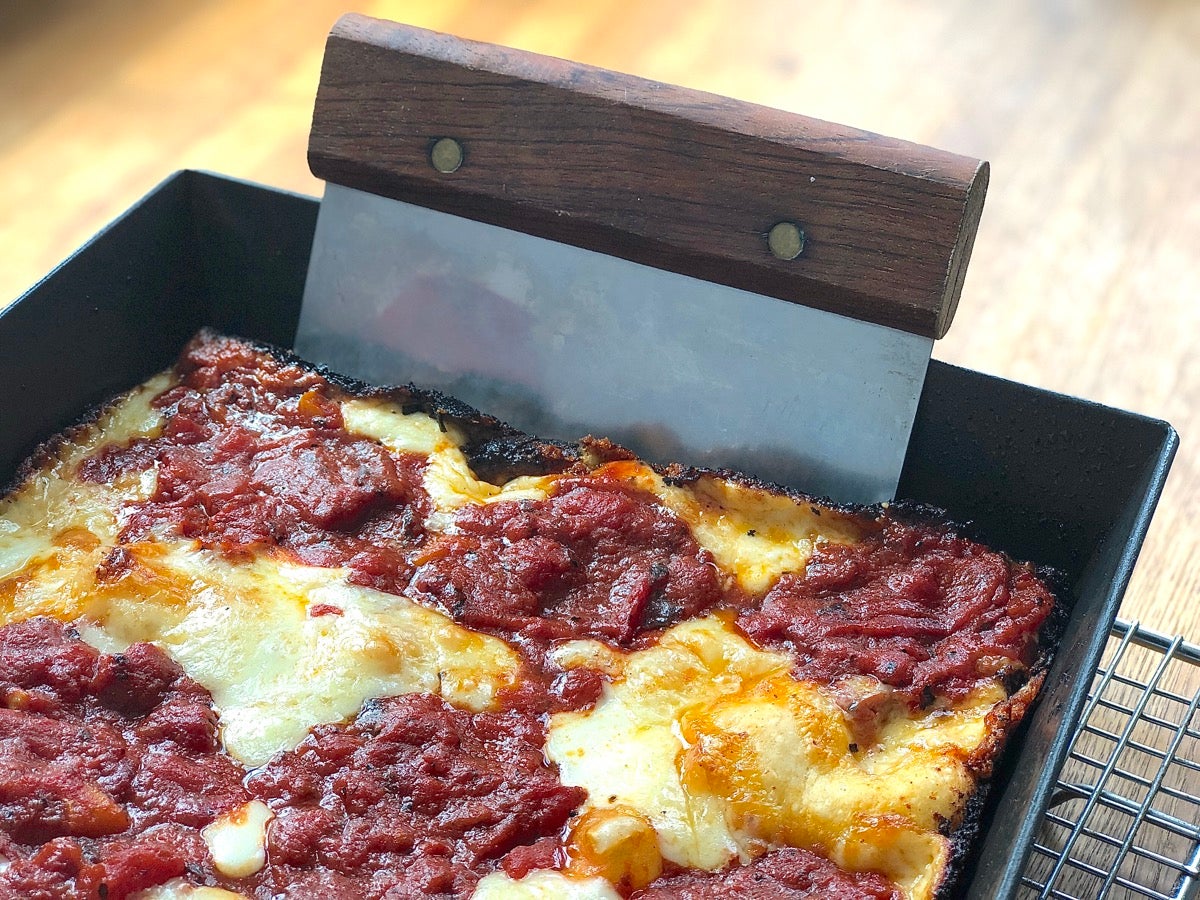
Remove the pizza from the oven, and immediately run a spatula or bench knife around the edges to loosen it from the pan. Trust me, do this right away; letting the pizza set for even a minute or so means the cooling cheese will cement it to the pan.
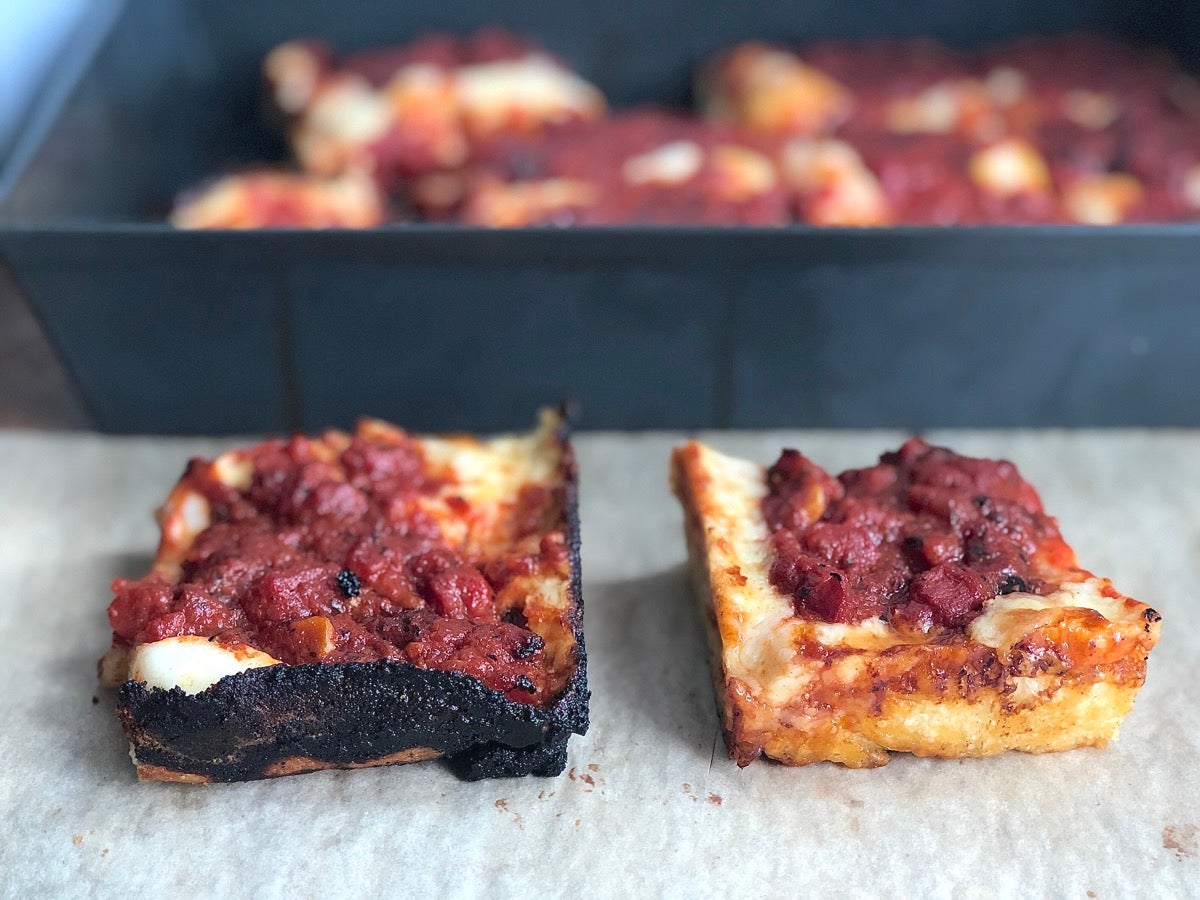
As soon as you can safely handle the hot pizza, transfer it to a cutting board, cut, and serve.
You'll probably decide that this pan pizza is more a knife-and-fork affair than something to eat out of hand. Dripping with sauce and cheese, it's a total indulgence.
Our test kitchen manager, Charlotte, says of this pan pizza, "Baked in a large, square pan at high heat after a relatively short final proofing time, the crust is wonderfully crispy and denser/thinner than traditional Sicilian-style pizza. Preparing the dough the day before ensures a fresh-from-the-oven pie in less than an hour, once you're ready to bake and serve."
Here's what you need:
For the crust:
2 cups (213g) Italian-Style Flour OR 1 3/4 cups (206g) King Arthur Unbleached All-Purpose Flour
2 cups (241g) King Arthur Unbleached All-Purpose Flour
1 tablespoon Pizza Dough Flavor
1 1/4 teaspoons salt
2 teaspoons instant yeast
1 1/4 cups (283g) lukewarm water
2 tablespoons (25g) olive oil, plus additional oil for greasing the pan
For the topping:
3 cups (12 ounces, 340g) shredded mozzarella cheese
1 1/4 cups (10 ounces, 283g) tomato or marinara sauce, store-bought or homemade

Combine all the ingredients in a large bowl and mix and knead to form a smooth, elastic dough. If you use 00 flour, expect the dough to be a tiny bit stickier, and the resulting crust a bit more tender.

Place the dough in a large (at least 5-quart) bowl, cover the bowl with plastic wrap (or your reusable wrap of choice), and place in the refrigerator for at least 4 hours or up to 24 hours.
Position a rack in the bottom third of the oven and preheat the oven to 500°F.

Add about 2 tablespoons of olive oil to a grandma-style pizza pan or an 18” x 13” baking sheet (half sheet pan) and spread it around to coat the pan. Just as with Detroit-style pizza, a dark pan will yield pizza with a crispy bottom and edges, while a lighter pan will result in a softer crust.

Turn the dough out into the pan, gently deflating it as you start to stretch it to the edges and corners. Due to the gluten tightening up and the oil in the pan offering it a slick surface, the dough will definitely shrink back.
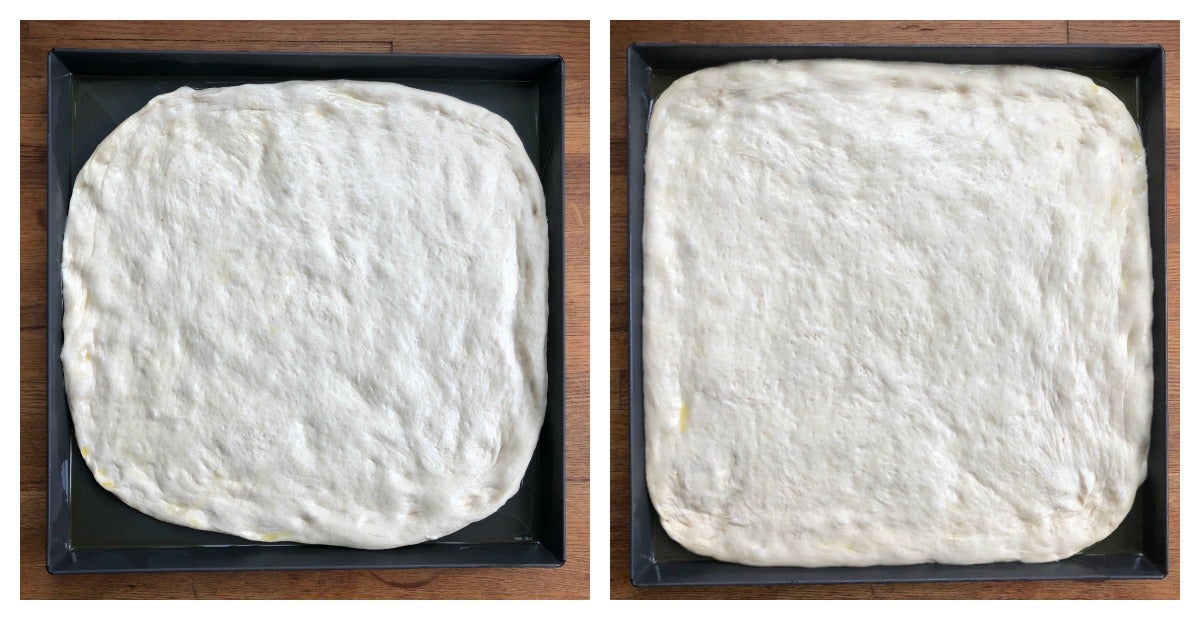 Don't fight it. When the dough starts to retreat, cover it with lightly greased plastic wrap (or your reusable wrap of choice) and let it rest for 10 minutes before resuming the stretching. This short rest relaxes the gluten, making it easier to shape.
Don't fight it. When the dough starts to retreat, cover it with lightly greased plastic wrap (or your reusable wrap of choice) and let it rest for 10 minutes before resuming the stretching. This short rest relaxes the gluten, making it easier to shape.
Try to stretch the dough all the way to the edge of the pan and into the corners.
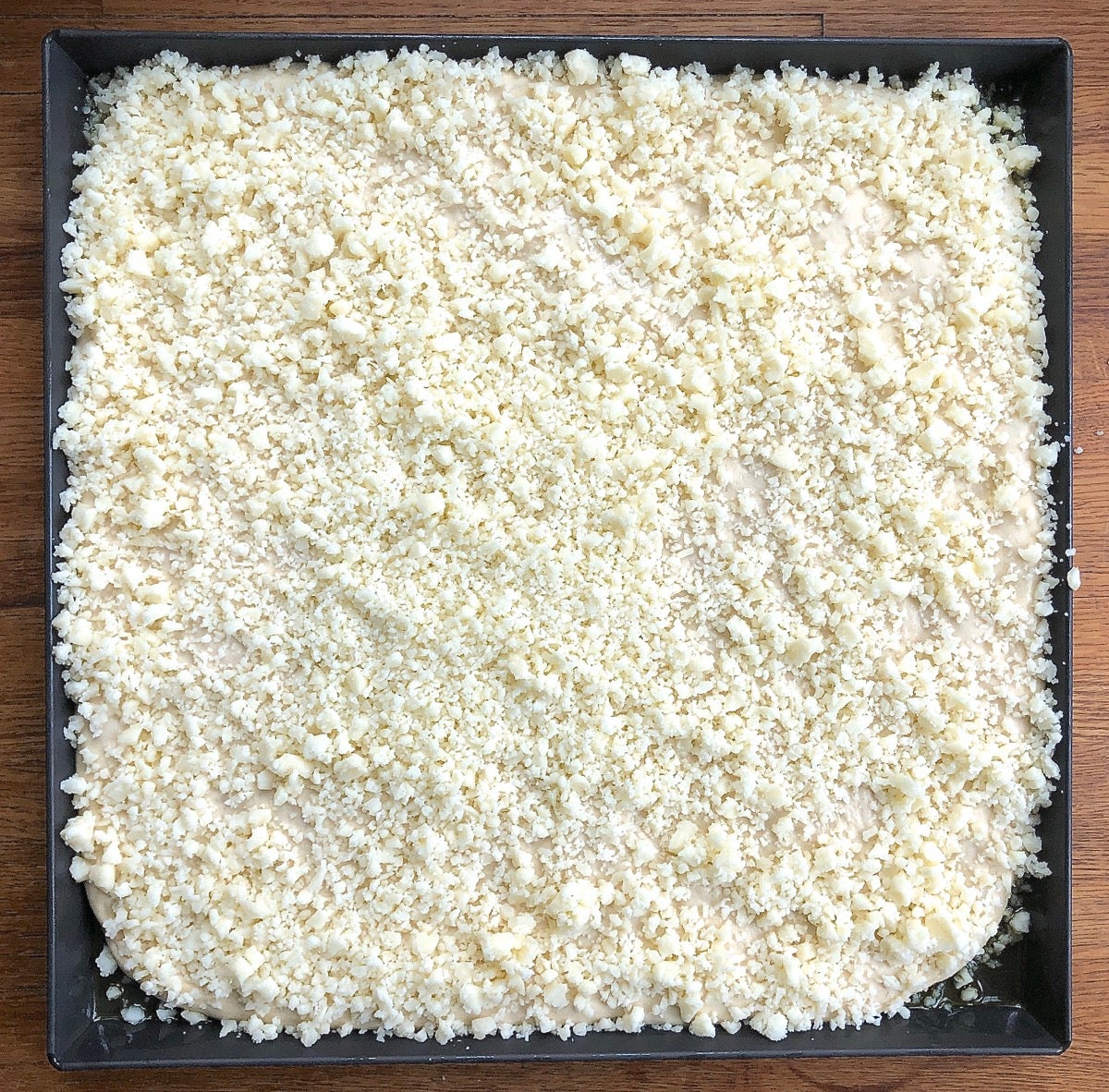
Once the crust is fully stretched, top it with the cheese, spreading it to the edges of the pan.

Finally, dollop or spread the sauce over the cheese. I'm using 1 14 cups (284g) of my favorite homemade sauce, Marcella Hazan's Tomato Sauce.
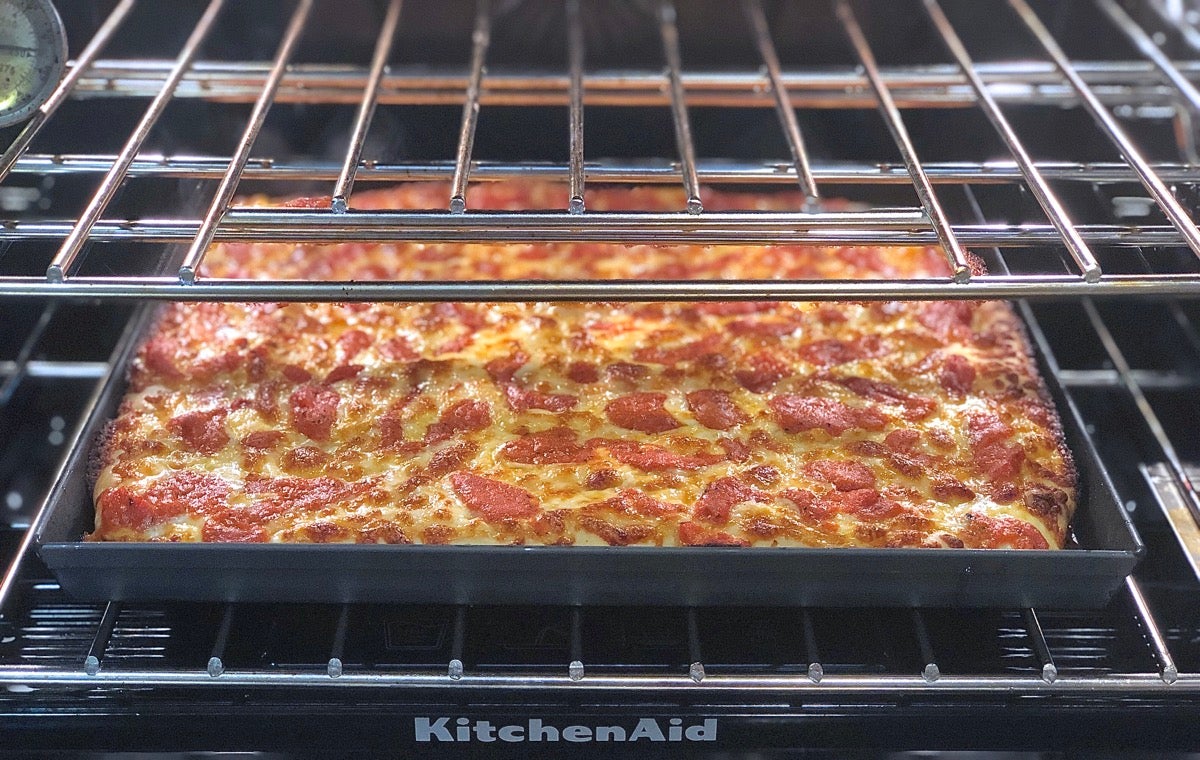
Bake the pizza in the bottom third of the oven for 12 to 15 minutes, until the cheese is bubbly and the crust is golden.

Remove the pizza from the oven, and immediately separate its edges from the pan, before the cheese cools and hardens.
Let the pizza cool for 5 to 10 minutes before serving.
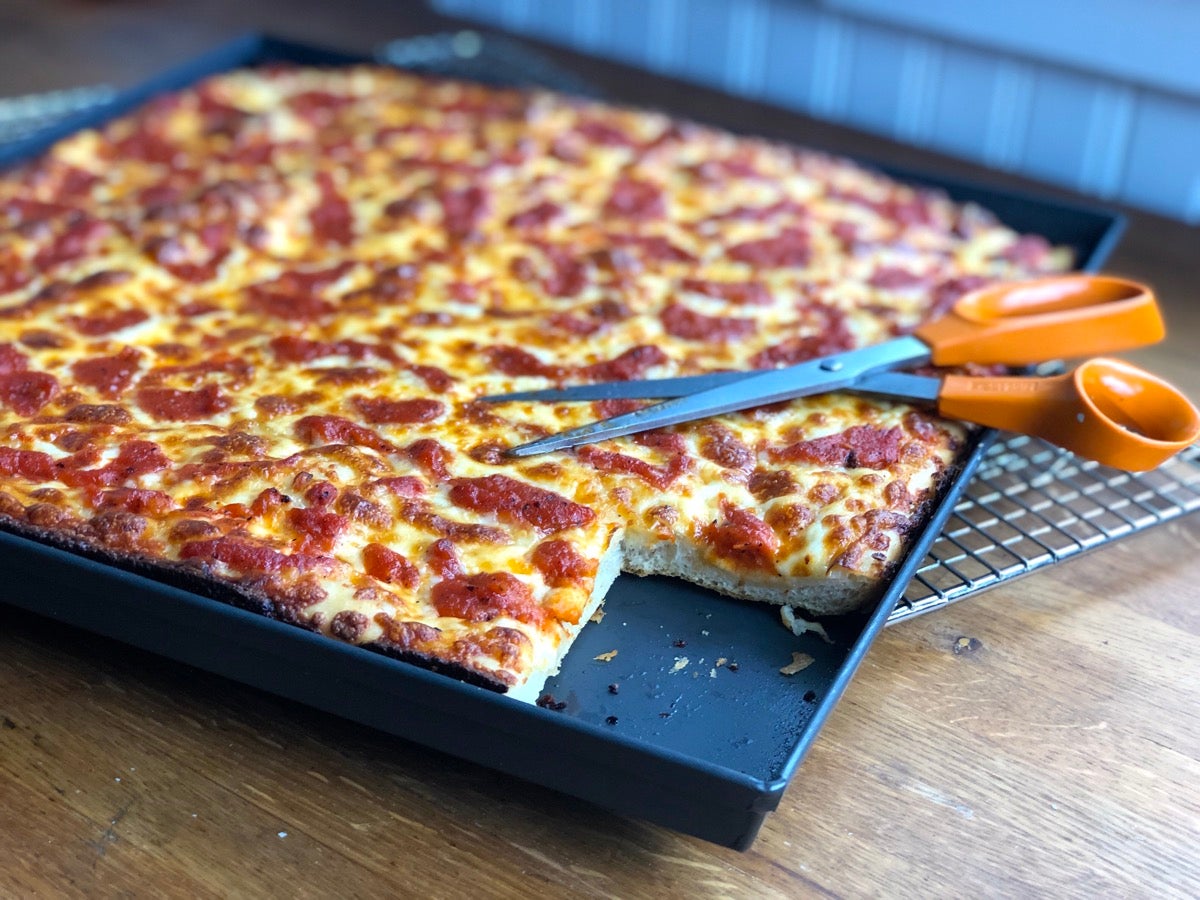
Best tool for cutting pan pizza? A pair of standard scissors.
Best way to enjoy pan pizza? With family and friends, of course. And if anyone professes to prefer thin-crust pizza, just call this "topped focaccia" and watch them dig in!
These thick-crust pies are just two of the many, many pizza recipes we offer. Check out our baker-tested online collection of pizza recipes for everything from Ultra-Thin Pizza Crust to The Easiest Pizza You'll Ever Make.